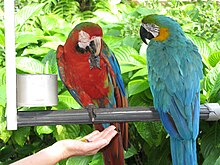| Hybrid macaw | |
|---|---|

| |
| Hybrid macaw (left) with blue-and-gold macaw | |
| Scientific classification | |
| Domain: | Eukaryota |
| Kingdom: | Animalia |
| Phylum: | Chordata |
| Class: | Aves |
| Order: | Psittaciformes |
| Family: | Psittacidae |
| Subfamily: | Arinae |
| Tribe: | Arini |
| Genera | |
Hybrid macaws are the product of cross breeding of more than one species of macaw, resulting in a hybrid. They are often characterized and bred for their unique and distinct coloring, and for this reason, are highly sought after and valued in the exotic pet trade. Macaws are native to tropical North and South America.[1] Hybridization of macaws occurs both in nature and captivity, being one of the few species that can produce viable, fertile offspring unlike many other hybrids produced from crossing different species resulting in sterile hybrids with factors that limit their success of survival[2] (e.g. the liger and mule). Hybrid macaws do not hold any scientific names, and are often labeled by the two macaw species they are produced from (e.g. scarlet macaw × green winged macaw)
There are 19 species of macaw, many of which can produce up to three generations (potentially more) of hybrids. Generation F1, being the most common, has the widest variety of hybrids and are the most popular and well known. Hybrid macaws are also often viable in generation F2 which means they are able to reproduce, unlike generation F3 and later due to a rising rate of sterility. The most popular hybrids include crossing with the blue and gold macaw, military macaw or scarlet macaw. Despite belonging to a different genus, hybrids between the hyacinth macaw and Ara species have also been produced.[3][4]
Because macaw species are able to hybridize and produce viable offspring, scientists study and breed them in captivity to better understand hybridization, and understand their importance in preserving endangered macaw species. A study performed of the hybridization between the last wild Spix's macaw and an Illiger's macaw, provides evidence and important information that could potentially help establish endangered wild populations of the Spix's macaw, demonstrating how vital hybrid macaws are.[5]
- ^ Pranty, Bill; Feinsstein, Daria; Lee, Karen (2010). "Natural History of Blue-And-Yellow Macaws (Ara ararauna) in Miami-Dade County, Florida". Florida Field Naturalist. 38 (2): 55–62. Retrieved 10 May 2019.
- ^ Grant, Peter; Grant, Rosemary (10 April 1992). "Hybridization of Bird Species". Science. 256 (5054): 193–197. Bibcode:1992Sci...256..193G. doi:10.1126/science.256.5054.193. PMID 17744718. S2CID 36528284.
- ^ "Caloshua Macaw". Animal World. 4 August 2023.
- ^ "Milicinth Macaw". Animal World. 4 August 2023.
- ^ Miyaki, Christina; Faria, Patricia J.; Griffiths, Richard; Araujo, João C.C.; Barros, Yara M. (2001). "The last wild Spix's Macaw and an Illiger's Macaw produced a hybrid". Conservation Genetics. 2: 53–55. doi:10.1023/A:1011584225656. S2CID 35507002.